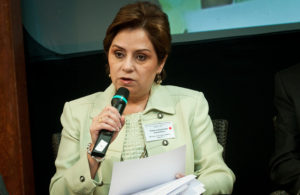Bolivia has completed pre-viability studies for its section of the mammoth railway set to connect the Pacific and Atlantic Oceans. Luis Alberto Arce, Bolivia’s finance minister, told Diálogo Chino the project, which could cost around US$14 billion in total and is backed by Chinese financiers and engineers, represented “a kind of Panama Canal in South America”.
René Orellana, Bolivia’s minister of development planning, said the studies gave them a base to start preparing a fuller financial analysis of the entire rail corridor, which will have huge capacity for transporting people and cargo. Orellana said the project would generate much-needed economic activity in the landlocked country. The US$5 million study was funded by the Inter-American Development Bank (IDB).
The interoceanic railway will extend 2330 miles (3750 kilometres) across South America and will transport 10 million tonnes of cargo per year starting in 2021. This figure could reach 24 million by 2050, the ministers said. It is estimated that the Bolivian section alone will cost around US$7 billion, likely to be financed by Chinese investors.
Orellana added that the project is advancing steadily after meetings between Bolivian president Evo Morales and Brazilian counterpart Dilma Rousseff. A working meeting between the Bolivians and Brazilians was held on April 15.
Technical meetings have also been held with Peru’s transport ministry with the two countries now in the proces of drawing up a memorandum of understanding. The project also had regional support in the form of Unasur, as secretary general Ernesto Samper joined negotiations in an attmept to establish a formal political agreement between the three nations.
The rail mega-project is seen as a solution to poor economic and infrastructure integration not only in the Andean region, but for Brazil and South America’s other landlocked country, Paraguay.
When asked about the environmental sustainability the project, the Bolivian officials said that the idea is to plan a multimodal rail, road and river scheme that will connect the waterways in the Prata and Amazon basins.
“We will include a modern transportation system with renewable energy sources. The large impact will be on the economy, as we will stimulate exports from one side of the region to the other. We need to integrate into global trade and production chains,” Orellana said.
Lithium mining
Bolivia’s plans to develop its lithium extraction industry are advancing well, the ministers said. Their goal is to turn Bolivia into a “major player” in the lithium and other associated industries, such as lithium ion battery manufacturing.
In addition to the Salar do Uyuni, the world’s largest salt plain which is located near the Andes in the departments of Potosí and Oruro, there are also plans to mine lithium at Salar de Coipasa in western Bolivia near the Chilean border.
“We already have an agreement with the Chinese to assess the possibility of economic exploitation of the salar,” Arce said.
Chinese company CITIC signed a contract with the Bolivian government to extract lithium and other mineral salts near Coipasa. Chinese firm Linyi Gelon New Battery Materials Company signed a deal to build a pilot lithium battery factory, and CAMC Engineering CO is set to build a plant for extracting and refining potassium chloride.
Bolivia is also using its own technology to extract potassium chloride from lithium carbonate. The next step is to expand and perform this activity on a larger scale. But to do this, Bolivia is “looking for a partner” who can help make a lithium plant a reality, and produce and export lithium batteries, explained Arce.
For Bolivia, lithium extraction would mean a chance to diversify its economy and generate new sources of foreign currency, moving away from its dependence on natural gas. The idea is to also become an important agricultural producer, since the potassium that will be extracted and separated from the lithium salts acts as a natural fertilizer for the soil.
Bolivia possesses around 60% of the world’s lithium reserves, according to Oreallana. He anticipates that strong demand from high-tech sectors such as electric vehicle manufacturing and the attendant high prices, which has risen 300% in the last few years, could transform Bolivia into the world’s foremost producer.
El Mutún
Bolivia’s dream of creating a steelworks on the fringes of one of the largest iron ore reserves in the world is also alive and well, the ministers say. Located in the department of Santa Cruz near the border with Brazil, the El Mutún mine stores about 40 billion tons of iron ore with extraction scheduled for later this year.
“We have never produced steel in the country, we had to import all iron and steel. We signed a contract with a Chinese company and we have a timeline to move forward,” Arce added, mentioning that China Exim Bank offered a credit of US$ 35 million to make the steelworks project a reality.
Arce says the potential of El Mutún is enormous, especially with China’s demand for iron ore. However, he adds, Bolivians should only allow China access to half the deposits, since they want to use the other half to produce steel “using their own hands”.
The Bolivian government announced a US$ 450 million contract to build and administer a plant with China’s Sinosteel in January this year.
This is the first attempt to operationalise El Mutún since work was halted following a long-running dispute with former rights holder Jindal steel of India. Arce is confident that the government is “mature” enough to be successful this time around.
According to Orellana, iron ore can be extracted without destroying the environment. El Mutún contains enormous natural wealth, and the Pantanal wetlands that encompass it was recognised in 2001 as a Ramsar Wetland of International Importance – an intergovernmental treaty which establishes national actions and cooperation between countries to conserve wetlands.
Orellana said mining at el Mutún would have the “least possible impact” but conceded that there needs to be a “balancing point” at which industrialisation, the use of natural resources, and preservation of ecosystems are reconciled.
“We will industrialise iron and produce steel, but of course the project must incorporate environmental precepts related to the sustainable use of water resources without serious ecological impacs,” Orellana said.


